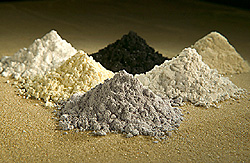Rare Earths Fall as Toyota Develops AlternativesBy Sonja ElmquistBloomberg Sep. 30, 2011 |
Popular 
Trump, After Rearming Israel, 'Frustrated' With Netanyahu for Expanding War

CNN: U.S. Officials Say Israel Preparing Possible Strike on Iran

U.S. Official Denies Report Trump Team Told Israel 'We Will Abandon You' If You Don't End Gaza War

Trump Confronts South African President on White Genocide

Report: Hamas Says Witkoff Promised to Lift Gaza Blockade in Exchange for Edan Alexander
  This is a perfect example of how the market rations scarce resources. You don't have to give some socialist dictator total power like the fake-green cult says, you just let the market function and people solve problems on their own. - ChrisRare-earth prices are set to extend their decline from records this year as buyers including Toyota Motor Corp. (7203) and General Electric Co. (GE) scale back using the materials in their cars and windmills. This is a perfect example of how the market rations scarce resources. You don't have to give some socialist dictator total power like the fake-green cult says, you just let the market function and people solve problems on their own. - ChrisRare-earth prices are set to extend their decline from records this year as buyers including Toyota Motor Corp. (7203) and General Electric Co. (GE) scale back using the materials in their cars and windmills.Prices for cerium and lanthanum, the most abundant rare- earth elements, will drop by 50 percent in 12 months, Christopher Ecclestone, an analyst at Hallgarten & Co. in New York, has forecast. Neodymium and praseodymium, metals used in permanent rare-earth magnets, may fall as much as 15 percent, he said. Makers of electric cars, wind turbines and oil-refining catalysts have sought to reduce use of the metals after China, which supplies more than 90 percent of the market, said in July 2010 that it would cut exports and clamp down on the industry. That boosted prices, encouraging mining companies to develop new prospects and buyers to find alternatives. “If you think you can keep raising the prices for those materials and still keep your customers, you’re crazy,” Jack Lifton, co-founder of Technology Metals Research, said in a telephone interview. “The principal customer for rare-earth metals is a global automotive industry using rare-earth permanent magnets. That industry will engineer this stuff out.” Declines in August and September pared a five-month, fourfold surge that brought the average price for eight of the most widely used rare-earth oxides to a record 396,850 yuan ($62,025) a metric ton in July, data from consultant Shanghai Steelhome Information show. The average price declined 13 percent from its July peak as of Sept. 27. Share Performance The Bloomberg Rare Earth Mineral Resources Index dropped 43 percent in the past three months, led by a 61 percent decline in Montreal-based Quest Rare Minerals Ltd. (QRM) Great Western Minerals Group Ltd., which explores in North America, climbed 3.1 percent in the period and is the only gainer on the 17-member benchmark. Rare earths have been pushed lower because of selling by speculators, Michael Gambardella, a New York-based analyst at JPMorgan Chase & Co., said in a report last week. Tsunami- related disruptions in Japan and dumping of unpermitted material in China have undercut prices, while industrial substitution has driven “demand destruction,” said Sam Berridge, a Sydney-based analyst at Royal Bank of Scotland Group Plc. “A greater focus on recycling and substitution, particularly by Japanese consumers, has resulted in tightness of demand easing somewhat for the lighter rare earths,” Berridge said by phone. ‘Huge Savings’ Rising prices for the so-called light metals, such as neodymium and lanthanum, have prompted automakers including Toyota, Asia’s biggest automaker, to look at reducing the use of relatively powerful and expensive rare-earth magnets in their vehicles. Some Toyota vehicles will be built with an induction motor, which doesn’t use rare-earth magnets, said John Hanson, a Toyota spokesman in Torrance, California. “Moving from a fixed-magnet motor to an induction motor is a huge savings with regard to rare-earth metals,” Hanson said by phone. “The Japanese are leading the push to replace, reduce and recycle their rare-earths consumption,” said Dudley Kingsnorth, chief executive officer of Perth-based advisory Industrial Minerals Co. of Australia. “Users are recycling rare earths wherever they can, using them more efficiently, particularly in the magnet industry where they are producing powerful magnets with smaller volumes.” Read More |



